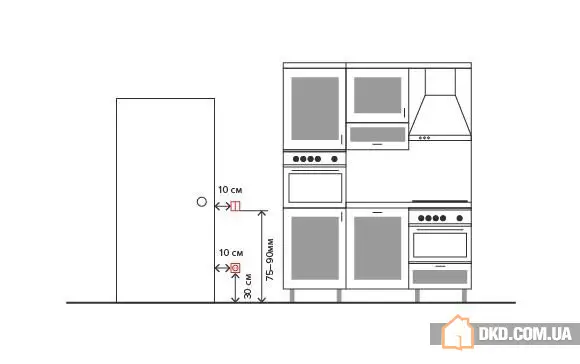There can be your advertisement
300x150
How to Properly Place Outlets and Switches on the Kitchen
Planning a kitchen renovation but unsure about the number and placement of outlets and switches? Want to create a functional and convenient space for cooking and family dinners, but afraid of getting tangled in cables? We explain and show where and how to place outlets and switches so you won't have to think about them until the next renovation.
1. For Built-in Household Appliances
Before planning the placement of outlets in the work zone, you need to determine how many household appliances you plan to use. Separate electric stoves or cooktops and ovens, refrigerators, dishwashers, microwave ovens, range hoods, kettles, toasters, multi-cookers, coffee machines - this is not a complete list of what is usually placed in the kitchen. Each appliance requires its own outlet. Don't forget about built-in cabinet and shelf lighting as well.

Kitchen outlets for built-in appliances are best installed behind the back panels of adjacent cabinets or shelves - to access them, you'll need to cut out the back panels. The recommended height for outlets in lower cabinets is 30-60 cm from the clean floor level. This option is most convenient - you will always have access to the power plugs. Remember that outlets should not be placed directly behind built-in kitchen electrical appliances. The outlet for the range hood is recommended to be installed at a height of 50-60 mm from the top of the kitchen cabinets. Ensure that the outlet is not blocked by ventilation ducts - the distance from the center of the range hood to the outlet should be more than 20 cm. Do not neglect reading the instructions - they always contain information about installing outlets for your specific model of household appliance.

2. For Small Household Appliances
Outlets above the countertop for connecting small household electrical appliances are usually placed at a height of 10-30 cm from the work surface. Never install outlets and switches behind the sink or stove: they may deform due to increased humidity and hot air. Outlets for lighting overhead cabinets can be conveniently placed at a height of 5-10 cm above them - that way they won't be visible.

3. For Additional Needs
The placement of additional outlets on the kitchen, for example, for a vacuum cleaner, is done at a height of 30-40 cm from the floor, and switches are installed at a height of 75-90 cm and 10-15 cm from the door frame. Sometimes the general kitchen switch is moved to the hallway.

4. For a Television
The placement of outlets for a television depends on where it will stand or hang, and the screen diagonal. Place them so that the television unit conceals them, but still leaves access to power plugs. You will need at least two standard electrical outlets, and one TV and internet outlet - for a modern television, the latter is simply necessary.

More articles:
 21 Beautiful Feminine Bedroom Ideas for Every Lady
21 Beautiful Feminine Bedroom Ideas for Every Lady Decorating Interior Walls with Thematic Mirror Sets
Decorating Interior Walls with Thematic Mirror Sets Sliding Doors — A Brilliant Solution for Limited Space
Sliding Doors — A Brilliant Solution for Limited Space 100 Tips for Every Situation in Life
100 Tips for Every Situation in Life 16 Genius Ideas for Crafty Hands to Effectively Store Your Office Supplies
16 Genius Ideas for Crafty Hands to Effectively Store Your Office Supplies 17 Unique Bookshelf Designs for True Book Lovers
17 Unique Bookshelf Designs for True Book Lovers Ideas for Marble Flooring for Your Home
Ideas for Marble Flooring for Your Home Terrace in Rural Style – Dream of Any Beauty and Peace Enthusiast
Terrace in Rural Style – Dream of Any Beauty and Peace Enthusiast